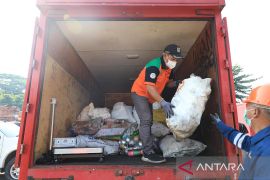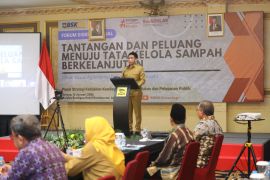The completion of this satellite became the proof of consistent efforts from students and supporting parties, including BRIN.Jakarta (ANTARA) - The Surya Satellite-1 (SS-1), developed by Surya University under the support and supervision of experts from the National Research and Innovation Agency's (BRIN's) Satellite Technology Research Center, will be launched from Japan in October 2022.
"The SS-1 becomes the starting point to develop the confidence that Indonesia is capable, which will produce other satellites," Head of the BRIN's Aviation and Space Research Organization Robertus Heru Riharjanto said in a statement issued on Monday.
Meanwhile, the launch of SS-1 from the International Space Station (ISS) is planned for November this year.
The satellite will be launched using one of the two space freighters— the SpaceX Dragon or Cygnus NG18.
The Surya Satellite-1 will be delivered to the Japan Aerospace Exploration Agency (JAXA) in Tsukuba, Japan, on June 29, 2022.
The SS-1 has passed the final stage of construction, namely assembly, integration, and testing. The SS-1 team will transport the satellite via air from Indonesia to Japan.
The construction of SS-1 was supported by stakeholders such as the Communication and Informatics Ministry, Indonesian Radio Amateur Organization (ORARI), PT Pudak Scientific, and PT Pasifik Satelit Nusantara.
"The completion of this satellite became the proof of consistent efforts from students and supporting parties, including BRIN," Triharjanto remarked.
The construction of Surya Satellite-1 is expected to motivate satellite developers in universities and showcase the capability of Indonesian human resources in developing space technology.
It is expected that, in the future, nano and micro satellites will not only be developed at BRIN, but in regions across Indonesia, whether by universities or the private sector.
The SS-1 project began in 2016 and was initiated by the Workshop Ground Station with ORARI. The satellite's mockup model was completed in 2018 under an amateur communication mission.
SS-1 team member Hery Steven Mindarno said that the satellite will serve as an Automatic Packet Reporting System, functioning as a communication media via satellite in the form of short messages.
"This technology can be developed for disaster mitigation, remote monitoring, and emergency communication," he informed.
In Japan, the satellite will be inspected and integrated with the launcher. SS-1 will have to go through an acceptance procedure to ensure that it has arrived safely and without a glitch during the delivery process.
The SS-1 will also undergo a satellite installation procedure at the JEM Small Satellite Orbital Deployer (JSSOD). JSSOD is a launcher module that will utilize the ISS during the process of releasing the satellite into its orbit.
"Until the launching period comes, the satellite must be kept in a clean, powered-down condition, and stored in a clean room so that it can still function well," Mindarno informed.
Related news: BRIN seeks to build self-reliance in satellite imagery
Related news: Satellite imaging database centralization saves state Rp15 tln: BRIN
Translator: Martha H S, Fadhli Ruhman
Editor: Rahmad Nasution
Copyright © ANTARA 2022












